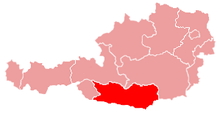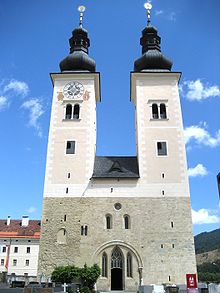- Roman Catholic Diocese of Gurk
-
Diocese of Gurk-Klagenfurt
Dioecesis Gurcensis
Dom Sankt Peter und PaulLocation Country Austria Territory Carinthia Ecclesiastical province Archdiocese of Salzburg Metropolitan Klagenfurt Population
- Catholics(as of 2004)
414,699Information Denomination Roman Catholic Rite Roman Rite Established March 6, 1071 Cathedral Dom Sankt Peter und Paul Co-cathedral Dom Maria Himmelfahrt, Gurk, Carinthia Patron saint Saint Hemma
John the BaptistCurrent leadership Pope Benedict XVI Bishop Alois Schwarz
Bishop of Gurk-KlagenfurtMetropolitan Archbishop Alois Kothgasser, SDB
Archbishop of SalzburgMap 
Website kath-kirche-kaernten.at The Roman Catholic Diocese of Gurk (Latin: Dioecesis Gurcensis, German: Diözese Gurk, Slovene: Krška Škofija) is a diocese comprising the Austrian state of Carinthia and is part of the Ecclesiastical province of Salzburg. Due to the presence of Carinthian Slovenes the Slovenian language is, together with Latin and German, the language of the liturgy in the Southern parts of the diocese. The organizational structures of the diocese are bilingual.
Contents
History
A prince-bishopric of Carinthia, suffragan to the Prince-Archbishopric of Salzburg, erected by Archbishop Gebhard of Salzburg, with the authorization of Pope Alexander II (21 March 1070) and Emperor Henry IV (4 February 1072). The first bishop installed was Günther von Krapffeld (1072–90). The right of appointment, consecration, and investiture of the Bishop of Gurk was reserved to the Archbishop of Salzburg. The episcopal residence was not at Gurk, but in the neighbouring castle at Strasburg.
The boundaries of the diocese were only defined in 1131, by Archbishop Konrad I of Salzburg. Originally the territory embraced was small, but the jurisdiction of the Bishop of Gurk extended beyond the limits of his diocese, inasmuch as he was also vicar-general of that part of Carinthia under the Archbishop of Salzburg.
Under Bishop Roman I (1132–67) the cathedral chapter obtained the right to elect the bishop, and only after a contest of a hundred years the metropolitan regained the right of appointment. Dissensions did not cease, for later the Austrian sovereign claimed the right of investiture. Finally, on 25 October 1535, the Archbishop of Salzburg, Matthäus Lang, concluded with the Habsburg house of Austria a long-lasting agreement, according to which the nomination of the Bishop of Gurk is to rest twice in succession with the Sovereign and every third time with the Archbishop of Salzburg; under all circumstances the archbishop was to retain the right of confirmation, consecration and investiture.
The diocese received an accession of territory under Emperor Joseph II in 1775, and again in 1786. The present extent of the diocese, embracing the whole of Carinthia, dates only from the reconstitution of the diocese in 1859. The episcopal residence was transferred in 1787 to the capital of Carinthia, Klagenfurt. A prominent modern prince-bishop was Valentin Wiery (1858–80).
According to the census of 1906, the Catholic population of the diocese was 369,000, of whom three-fourths German and the rest Slovenes. The 24 deaneries embraced 345 parishes[citation needed]. The cathedral chapter at Klagenfurt consisted of three mitred dignitaries; five honorary and five stipendiary canons. Among the institutions of religious orders the Benedictine Abbey of St. Paul (founded in 1091; suppressed in 1782; restored in 1807) holds first place. There were also Jesuits at Klagenfurt and St. Andrä; Dominicans at Friesach; Capuchins at Klagenfurt and Wolfsberg; Franciscans at Villach; Olivetans at Tanzenberg; Servites at Kötsehach; Brothers of Mercy at St. Veit on the Glan (in charge of an immense hospital founded in 1877); and a number of religious communities of women for the care of the sick and the instruction of youth.
The clergy are trained in the episcopal seminary at Klagenfurt, which has been, since 1887, under the direction of the Jesuits. The professors are Benedictines from the Abbey of St. Paul and Jesuits. The education of aspirants to the priesthood is provided for at Klagenfurt, in a preparatory seminary established by Bishop Wiery in 1860 and enlarged by Bishop Kahn. At St. Paul's the Benedictines conduct a private gymnasium with the privileges of a government school. At Klagenfurt there is also a Catholic teachers' seminary under ecclesiastical supervision.
Chief among the examples of ecclesiastical architecture, both in point of age and artistic interest, is the cathedral at Gurk, which dates back to the beginnings of the diocese, having been completed about 1220. Also worthy of note are the Gothic cloister of the church at Milstadt and, as monuments of Gothic architecture, the parish churches at St. Leonard in the Lavant-Thal, Heiligenblut, Villach, Völkermarkt, Grades (St. Wolfgang), and Waitschach. One of the largest and most beautiful churches of Carinthia is the recently renovated (1884–90) Dominican church at Friesach. The present cathedral at Klagenfurt was built in 1591 by the Protestants; in 1604 it was acquired by the Jesuits, and consecrated in honour of the Apostles Saints Peter and Paul.
Prominent among the places of pilgrimage in the diocese is Maria Saal, visited annually by from 15,000 to 20,000 pilgrims. Among Catholic associations special mention should be made of those for the advancement of the Catholic Press and for the diffusion of good books: for the German population, the St. Joseph's Verein founded at Klagenfurt in 1893, and the St. Joseph's Book Confraternity; for the Slovenes, the St. Hermagoras Verein, established in 1852 (1860), with its headquarters at Klagenfurt, and widely established among Slovenes in other dioceses.
Special churches
- Former Cathedral:
- Dom Sankt Andrä, Sankt Andrä im Lavanttal, Kärnten
- Wallfahrtskirche Maria Himmelfahrt, Maria Saal, Kärnten
- Minor Basilica:
- Maria Luggau, Maria Luggau, Kärnten
Leadership
- Bishops of Gurk (Roman rite)
- Bishop Alois Schwarz (since 2001.05.22)
- Bishop Egon Kapellari (1981.12.07 – 2001.03.14)
- Bishop Josef Köstner (1945.06.25 – 1981.04.25)
- Archbishop Adam Hefter (1914.12.26 – 1939.05.04)
- Archbishop Balthasar Kaltner (1910.11.03 – 1914.05.25)
- Bishop Josef Kahn (1887.02.10 – 1910.10.28)
- Bishop Peter Funder (1881.03.30 – 1886.10.01)
- Bishop Valentin Wiery (1858.10.30 – 1880.12.29)
- Bishop Adalbert Lidmansky (1842.05.13 – 1858.07.23)
- Bishop Franz Anton Gindl (1841.01.23 – 1841.10.24)
- Bishop Georg Mayer (1827.10.14 – 1840.03.22)
- Bishop Jakob Peregrin Paulitsch (1824.02.09 – 1827.01.05)
- Cardinal Franziskus Xavier von Salm-Reifferscheidt (1783.11.20 – 1822.04.19)
- Cardinal Joseph Franz von Paula von Auersperg (1772.10.18 – 1783.05.19)
- Archbishop Hieronymus Joseph Franz de Paula Graf Colloredo von Wallsee und Mels (1761.12.19 – 1772.04.14)
- Bishop Josef Maria Reichsgraf von Thun und Hohenstein (1741.10.07 – 1762.03.29)
- Bishop Jakob Maximilian Reichsgraf von Thun und Hohenstein (1709.08.30 – 1741.07.26)
- Bishop Otto de la Bourde (1697.01.12 – 1708.12.24)
- Cardinal Johannes von Goes (1675.10.05 – 1696.10.19)
- Bishop Polykarp Wilhelm Reichsgraf von Kuenburg (1674.02.24 – 1675.07.15)
- Bishop Wenzeslaus Reichsgraf von Thun (1665.08.10 – 1673.01.08)
- Bishop Sigmund Franz Erzherzog von Österreich (1653.11.02 – 1665.05.28)
- Bishop Franz Reichsgraf von Lodron (1644.03.05 – 1652.11.30)
- Bishop Urban Sagstetter (1556.07.03 – 1573.10.13)
- Bishop Antonio Hoyos de Salamanca (1526.06.25 – 1550)
- Cardinal Matthäus Lang von Wellenburg (1505.10.06 – 1522.03.11)
- Bishop Sixtus von Tannberg (1470.04.23 – 1495.07.14)
See also
Sources
- Giga-Catholic Information
- Catholic Hierarchy
- Diocese website
 "Diocese of Gurk". Catholic Encyclopedia. New York: Robert Appleton Company. 1913.
"Diocese of Gurk". Catholic Encyclopedia. New York: Robert Appleton Company. 1913.
Province of Salzburg Archdiocese of Salzburg · Diocese of Feldkirch · Diocese of Graz-Seckau · Diocese of Gurk · Diocese of InnsbruckProvince of Vienna Sui iuris Jurisdictions Categories:- Roman Catholic dioceses in Austria
- Roman Catholic dioceses established in the 11th century
- Roman Catholic Ecclesiastical Province of Salzburg
- Former Cathedral:
Wikimedia Foundation. 2010.


